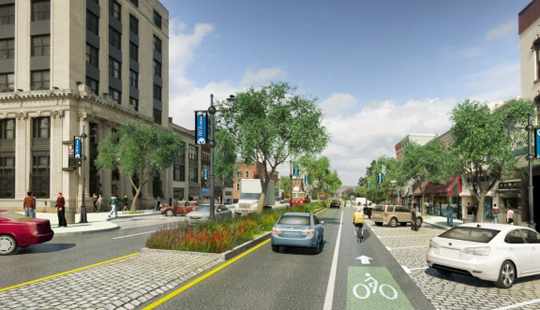
Rendering of North Union Street in Olean looking north from Laurens Street. For more information, visit www.walkableolean.com.
Jamestown and Olean have a lot in common as small urban centers in the Southern Tier. That was on display this past weekend when Jamestown Community College, a shared institution, celebrated Commencement at its campuses in both cities.
But it’s also visible in efforts to create vibrant downtowns as a way to attract new businesses and make it easier for existing businesses to attract skilled workers. On that front, both cities are making progress and both have a ways to go. But Olean is taking risks and making strides that are well worth noting at this end of I-86.
Consider Olean’s North Union Street project, an $8.8 million reconstruction and reconfiguration of that city’s primary downtown thoroughfare. In place of a dreary four-lane traffic artery, the city and NYSDOT are installing a brand new streetscape that will feature roundabouts, bike lanes, landscaped medians, and a reduction in traffic lanes from four to two. On a street that carries twice as much traffic as Fourth Street in downtown Jamestown (which carries three lanes of one-way traffic), Olean is going with something slimmer, greener, and more functional.
It’s a big project that is causing a commensurate level of disruption during its two-year construction period, which will wrap up in 2016. And plenty of people are worried about the roundabouts and bike lanes and how local drivers will respond to the changes.
But as similar projects in other cities demonstrate, people get the hang of roundabouts fairly quickly. And more importantly, investments in walkable, pedestrian-friendly downtown streets are catalysts for reinvestment and reinvention.
On its own, the new streetscape will instantly make properties along North Union more appealing to developers because the environment will be more appealing to potential tenants (both commercial and residential). But to help prime investment in Olean’s historic downtown building stock, other steps are being taken, including an effort led by the private sector to add downtown Olean to the National Register of Historic Places.
The historic district designation, which is expected to have federal sign-off within a few months, will make 23 properties eligible for federal and state tax credits that are often crucial to financing costly renovations to older buildings, especially in cities with relatively weak real estate markets. Such incentives were made available to over 100 buildings in downtown Jamestown last year when a similar district was established, helping to pave the way for the current renovation of the M&T Bank Building at Main & Third into a new home for Digitell Inc.
Besides creating the right conditions for businesses, employees, and residents to desire a downtown Olean location, plans are also in the works to cultivate new economic activity. A business incubator project in a vacant four-story building is being led by a consortium that includes the Greater Olean Chamber of Commerce, Olean Enterprise Development, and the Cattaraugus Empire Zone Corporation. The project has support from a $400,000 state grant towards a $2 million goal. Nearby, adjacent to its downtown Olean campus, JCC is investing another $2 million to turn an old Knights of Columbus hall into a center for engineering and advanced manufacturing. Both projects will leverage the engineering, design, and entrepreneurial skills already present in the Olean workforce (think Dresser-Rand, CUTCO, and Cooper Power) to generate a healthy churn of experimental enterprises.
These projects are materializing because of smart long-term planning by the public and private sectors, aggressive prospecting for outside resources, and a willingness on the part of the city to invest in itself. The North Union Street project is made possible by an infusion of over $6 million in highly competitive federal funds, but the city is putting in a million on its own – quite a bit for a city of 15,000. And while the federal and state historic tax credits will be nice incentives to have in place, it’s even more important that private investors are stepping to the plate with their own capital, sensing that the city’s overall momentum is on their side.
As Jamestown and Olean continue to meet the challenges that face every small city with an industrial past, it’s worth spending some time to compare notes and learn from each other. If prosperity is a goal for the Southern Tier, it won’t happen unless these two cities lead the charge together.
–Peter Lombardi
This post originally appeared in The Post-Journal on May 18, 2015, as the JRC’s biweekly Renaissance Reflections feature.
